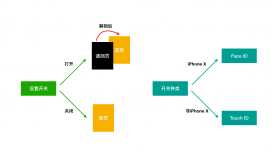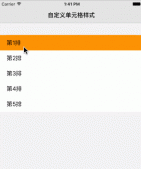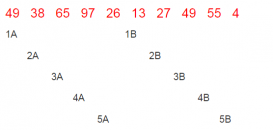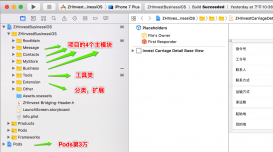本文实例为大家分享了Swift实现表格视图单元格单选的具体代码,供大家参考,具体内容如下
效果
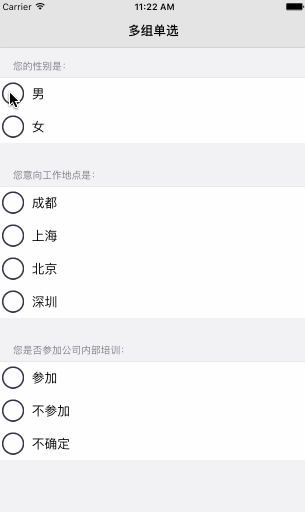
前言
前段时间写了一篇博客: 表格视图单元格单选(一),实现起来并不复杂,简单易懂。在实际开发中,可能会涉及到更为复杂的操作,比如多个section 下的单选,如上面展示的效果,当我们有这样的需求的时候,该如何实现呢?因为,在上篇文章中我所用的控件都是单元格自带的imageView以及textLabel,本文我将主要分享自定义选择按钮以及在多个section下实现单选的方法。
准备
界面搭建与数据显示
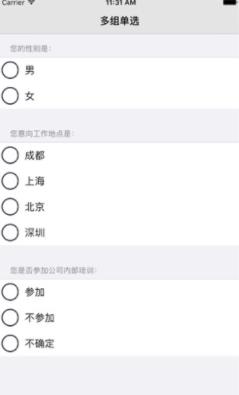
这样的界面相信对大家而言,并不难,这里我不再做详细的讲解,值得一提的是数据源的创建,每一组的头部标题,我用一个数组questions存储,类型为:[String]?,由于每一组中,单元格内容不一致,因此建议用字典存储。如下所示:
|
1
2
|
var questions: [String]?var answers: [String:[String]]? |
如果我用字典来存储数据,那字典的键我应该如何赋值呢?其实很简单,我们只需将section的值作为key 就Ok了,这样做的好处在于,我可以根据用户点击的 section来处理对应的数据,我们知道,表格视图的section 从 0 开始,因此字典赋值可以像下面提供的代码一样赋值,但要注意,answers的值需与questions里面的问题一致,才能满足实际的需求。
|
1
2
3
4
5
6
7
|
self.questions = ["您的性别是:", "您意向工作地点是:", "您是否参加公司内部培训:"]self.answers = ["0":["男", "女"], "1":["成都", "上海", "北京", "深圳"], "2":["参加", "不参加","不确定"]] |
接下来需要做的事情就是自定义单元格(UITableViewCell)了,比较简单,直接上代码,代码中涉及到的图片素材可到阿里矢量图中下载:
|
1
2
3
4
5
6
7
8
9
10
11
12
13
14
15
16
17
18
19
20
21
22
23
24
25
26
27
28
29
30
31
32
33
34
35
36
37
38
39
40
41
42
43
44
45
46
47
48
|
import UIKitclass CustomTableViewCell: UITableViewCell { var choiceBtn: UIButton? var displayLab: UILabel? override init(style: UITableViewCellStyle, reuseIdentifier: String?) { super.init(style: style, reuseIdentifier: reuseIdentifier) self.initializeUserInterface() } required init?(coder aDecoder: NSCoder) { fatalError("init(coder:) has not been implemented") } // MARK:Initialize methods func initializeUserInterface() { self.choiceBtn = { let choiceBtn = UIButton(type: UIButtonType.Custom) choiceBtn.bounds = CGRectMake(0, 0, 30, 30) choiceBtn.center = CGPointMake(20, 22) choiceBtn.setBackgroundImage(UIImage(named: "iconfont-select.png"), forState: UIControlState.Normal) choiceBtn.setBackgroundImage(UIImage(named: "iconfont-selected.png"), forState: UIControlState.Selected) choiceBtn.addTarget(self, action: Selector("respondsToButton:"), forControlEvents: UIControlEvents.TouchUpInside) return choiceBtn }() self.contentView.addSubview(self.choiceBtn!) self.displayLab = { let displayLab = UILabel() displayLab.bounds = CGRectMake(0, 0, 100, 30) displayLab.center = CGPointMake(CGRectGetMaxX(self.choiceBtn!.frame) + 60, CGRectGetMidY(self.choiceBtn!.frame)) displayLab.textAlignment = NSTextAlignment.Left return displayLab }() self.contentView.addSubview(self.displayLab!) } // MARK:Events func respondsToButton(sender: UIButton) { }} |
表格视图数据源与代理的实现,如下所示:
|
1
2
3
4
5
6
7
8
9
10
11
12
13
14
15
16
17
18
19
20
21
22
23
24
25
26
27
28
29
30
31
32
33
34
35
36
37
38
39
40
|
// MARK:UITableViewDataSource && UITableViewDelegatefunc numberOfSectionsInTableView(tableView: UITableView) -> Int { // 直接返回 answers 键值对个数即可,也可返回 questions 个数; return (self.answers!.count)}func tableView(tableView: UITableView, numberOfRowsInSection section: Int) -> Int { // 根据 section 获取对应的 key let key = "\(section)" // 根据 key 获取对应的数据(数组) let answers = self.answers![key] // 直接返回数据条数,就是需要的行数 return answers!.count}func tableView(tableView: UITableView, cellForRowAtIndexPath indexPath: NSIndexPath) -> UITableViewCell { var cell: CustomTableViewCell? = tableView.dequeueReusableCellWithIdentifier("cell") as? CustomTableViewCell if cell == nil { cell = CustomTableViewCell(style: UITableViewCellStyle.Default, reuseIdentifier: "cell") } let key = "\(indexPath.section)" let answers = self.answers![key] cell!.selectionStyle = UITableViewCellSelectionStyle.None return cell!}func tableView(tableView: UITableView, heightForHeaderInSection section: Int) -> CGFloat { return 40}func tableView(tableView: UITableView, titleForHeaderInSection section: Int) -> String? { return self.questions![section]} |
实现
技术点:在这里我主要会用到闭包回调,在自定义的单元格中,用户点击按钮触发方法时,闭包函数会被调用,并将用户点击的单元格的indexPath进行传递,然后根据indexPath进行处理,具体的实现方式,下面会慢慢讲到,闭包类似于Objective-C中的Block,有兴趣的朋友可深入了解Swift中的闭包使用。
首先,我们需要在CustomTableViewCell.swift文件中,声明一个闭包类型:
|
1
|
typealias IndexPathClosure = (indexPath: NSIndexPath) ->Void |
其次,声明一个闭包属性:
|
1
|
var indexPathClosure: IndexPathClosure? |
现在,要做的事情就是声明一个闭包函数了,闭包函数主要用于在ViewController.swift文件中调用并且将需要传递的数据传递到ViewController.swift文件中。
|
1
2
3
|
func getIndexWithClosure(closure: IndexPathClosure?) { self.indexPathClosure = closure } |
闭包函数已经有了,那么何时调用闭包函数呢?当用户点击单元格的时候,闭包函数会被调用,因此,我们只需要到选择按钮触发方法中去处理逻辑就好了,在触发方法中,我们需要将单元格的indexPath属性传递出去,但是,UITableViewCell并无indexPath属性,那应该怎么办呢?我们可以为它创建一个indexPath属性,在配置表格视图协议方法cellForRowAtIndexPath:时,我们赋值单元格的indexPath属性就OK了。
|
1
|
var indexPath: NSIndexPath? |
|
1
2
3
4
5
6
|
func respondsToButton(sender: UIButton) { sender.selected = true if self.indexPathClosure != nil { self.indexPathClosure!(indexPath: self.indexPath!) }} |
现在在CustomTableViewCell.swift文件里面的操作就差不多了,但是,还缺少一步,我还需要定制一个方法,用于设置按钮的状态:
|
1
2
3
4
5
|
func setChecked(checked: Bool) { self.choiceBtn?.selected = checked} |
到了这一步,我们要做的事情就是切换到ViewController.swift文件中,找到表格视图协议方法cellForRowAtIndexPath:,主要的逻辑就在这个方法中处理,首先我们需要做的事情就是赋值自定义单元格的indexPath属性:
|
1
|
cell?.indexPath = indexPath |
其次,我需要在ViewController.swift文件中,声明一个selectedIndexPath属性用于记录用户当前选中的单元格位置:
|
1
|
var selectedIndexPath: NSIndexPath? |
接下来我会去做一个操作,判断协议方法参数indexPath.row,是否与selectedIndexPath.row一致,如果一致,则设为选中,否则设为未选中,这里可用三目运算符:
|
1
|
self.selectedIndexPath?.row == indexPath.row ? cell?.setChecked(true) : cell?.setChecked(false) |
这里大家可能会有疑问,那就是为什么只判断row呢?不用判断section吗?当然不用,因为在刷新表格视图的时候我并没有调用reloadData方法,而是指定刷新某一组(section)就可以了,如果全部刷新,则无法保留上一组用户选择的信息,这将不是我们所需要的。
接下来,将是最后一步,调用回调方法,该方法会在每一次用户点击单元格的时候调用,并且返回用户当前点击的单元格的indexPath,在这里,我们需要将返回的indexPath赋值给selectedIndexPath属性。并且刷新指定section就OK了,代码如下:
|
1
2
3
4
5
6
7
|
cell!.getIndexWithClosure { (indexPath) -> Void in self.selectedIndexPath = indexPath print("您选择的答案是:\(answers![indexPath.row])") tableView.reloadSections(NSIndexSet(index: self.selectedIndexPath!.section), withRowAnimation: UITableViewRowAnimation.Automatic) } |
完整代码
可能大家还比较模糊,这里我将贴上完整的代码供大家参考
ViewController.swift文件
|
1
2
3
4
5
6
7
8
9
10
11
12
13
14
15
16
17
18
19
20
21
22
23
24
25
26
27
28
29
30
31
32
33
34
35
36
37
38
39
40
41
42
43
44
45
46
47
48
49
50
51
52
53
54
55
56
57
58
59
60
61
62
63
64
65
66
67
68
69
70
71
72
73
74
75
76
77
78
79
80
81
82
83
84
85
86
87
88
89
90
91
92
93
94
95
|
import UIKitclass ViewController: UIViewController, UITableViewDataSource, UITableViewDelegate{ var tableView: UITableView? var questions: [String]? var answers: [String:[String]]? var selectedIndexPath: NSIndexPath? override func viewDidLoad() { super.viewDidLoad() self.initializeDatasource() self.initializeUserInterface() // Do any additional setup after loading the view, typically from a nib. } // MARK:Initialize methods func initializeDatasource() { self.questions = ["您的性别是:", "您意向工作地点是:", "您是否参加公司内部培训:"] self.answers = ["0":["男", "女"], "1":["成都", "上海", "北京", "深圳"], "2":["参加","不参加","不确定"]] } func initializeUserInterface() { self.title = "多组单选" self.automaticallyAdjustsScrollViewInsets = false // table view self.tableView = { let tableView = UITableView(frame: CGRectMake(0, 64, CGRectGetWidth(self.view.bounds), CGRectGetHeight(self.view.bounds)), style: UITableViewStyle.Grouped) tableView.dataSource = self tableView.delegate = self return tableView }() self.view.addSubview(self.tableView!) } // MARK:UITableViewDataSource && UITableViewDelegate func numberOfSectionsInTableView(tableView: UITableView) -> Int { return (self.answers!.count) } func tableView(tableView: UITableView, numberOfRowsInSection section: Int) -> Int { let key = "\(section)" let answers = self.answers![key] return answers!.count } func tableView(tableView: UITableView, cellForRowAtIndexPath indexPath: NSIndexPath) -> UITableViewCell { var cell: CustomTableViewCell? = tableView.dequeueReusableCellWithIdentifier("cell") as? CustomTableViewCell if cell == nil { cell = CustomTableViewCell(style: UITableViewCellStyle.Default, reuseIdentifier: "cell") } cell?.indexPath = indexPath let key = "\(indexPath.section)" let answers = self.answers![key] self.selectedIndexPath?.row == indexPath.row ? cell?.setChecked(true) : cell?.setChecked(false) cell!.getIndexWithClosure { (indexPath) -> Void in self.selectedIndexPath = indexPath print("您选择的答案是:\(answers![indexPath.row])") tableView.reloadSections(NSIndexSet(index: self.selectedIndexPath!.section), withRowAnimation: UITableViewRowAnimation.Automatic) } cell!.displayLab?.text = answers![indexPath.row] cell!.selectionStyle = UITableViewCellSelectionStyle.None return cell! } func tableView(tableView: UITableView, heightForHeaderInSection section: Int) -> CGFloat { return 40 } func tableView(tableView: UITableView, titleForHeaderInSection section: Int) -> String? { return self.questions![section] }} |
CustomTableViewCell.swift文件
|
1
2
3
4
5
6
7
8
9
10
11
12
13
14
15
16
17
18
19
20
21
22
23
24
25
26
27
28
29
30
31
32
33
34
35
36
37
38
39
40
41
42
43
44
45
46
47
48
49
50
51
52
53
54
55
56
57
58
59
60
61
62
63
64
65
66
67
68
69
|
import UIKittypealias IndexPathClosure = (indexPath: NSIndexPath) ->Voidclass CustomTableViewCell: UITableViewCell { var choiceBtn: UIButton? var displayLab: UILabel? var indexPath: NSIndexPath? var indexPathClosure: IndexPathClosure? override init(style: UITableViewCellStyle, reuseIdentifier: String?) { super.init(style: style, reuseIdentifier: reuseIdentifier) self.initializeUserInterface() } required init?(coder aDecoder: NSCoder) { fatalError("init(coder:) has not been implemented") } // MARK:Initialize methods func initializeUserInterface() { self.choiceBtn = { let choiceBtn = UIButton(type: UIButtonType.Custom) choiceBtn.bounds = CGRectMake(0, 0, 30, 30) choiceBtn.center = CGPointMake(20, 22) choiceBtn.setBackgroundImage(UIImage(named: "iconfont-select"), forState: UIControlState.Normal) choiceBtn.setBackgroundImage(UIImage(named: "iconfont-selected"), forState: UIControlState.Selected) choiceBtn.addTarget(self, action: Selector("respondsToButton:"), forControlEvents: UIControlEvents.TouchUpInside) return choiceBtn }() self.contentView.addSubview(self.choiceBtn!) self.displayLab = { let displayLab = UILabel() displayLab.bounds = CGRectMake(0, 0, 100, 30) displayLab.center = CGPointMake(CGRectGetMaxX(self.choiceBtn!.frame) + 60, CGRectGetMidY(self.choiceBtn!.frame)) displayLab.textAlignment = NSTextAlignment.Left return displayLab }() self.contentView.addSubview(self.displayLab!) } // MARK:Events func respondsToButton(sender: UIButton) { sender.selected = true if self.indexPathClosure != nil { self.indexPathClosure!(indexPath: self.indexPath!) } } // MARK:Private func setChecked(checked: Bool) { self.choiceBtn?.selected = checked } func getIndexWithClosure(closure: IndexPathClosure?) { self.indexPathClosure = closure }} |
以上就是本文的全部内容,希望对大家的学习有所帮助,也希望大家多多支持服务器之家。
原文链接:https://blog.csdn.net/Hierarch_Lee/article/details/50112929

